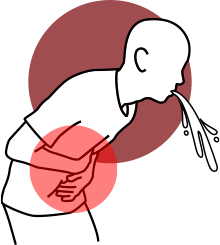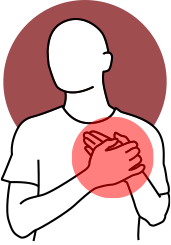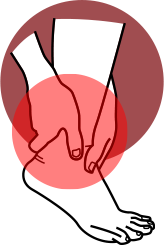Diabetic Peripheral Neuropathy
Overview
Diabetic Neuropathy Types
Peripheral Neuropathy
Another term used is distal symmetric peripheral neuropathy. Diabetic neuropathy of this sort is the most frequent. The feet and legs are initially affected, followed by the hands and arms. The following are some of the signs and symptoms of peripheral neuropathy that are often worse at night:
- Sharp pains or cramps
- Increased sensitivity to touch
- Severe foot problems, such as bone and joint discomfort, infections, ulcers, etc.
Autonomic Neuropathy
The autonomic nerve system regulates your heart, bladder, stomach, intestines, sex organs, and eyes. Diabetic nerve injury can occur in any of these regions, resulting in the following symptoms:
- Low blood sugar levels go unnoticed due to a lack of awareness
- Bladder or bowel problems
- Changes in the capacity of your eyes to adapt from light to dark
Proximal Neuropathy
This type of neuropathy, also known as diabetic amyotrophy or diabetic polyradiculopathy, frequently affects the nerves in the thighs, hips, buttocks, or legs. However, it might impact the chest and abdomen as well. The symptoms normally appear on one side of the body, although they can move to the other.
- Severe hip, thigh, or buttock pain
- Eventual weak and shrinking thigh muscles
- Difficulty rising from a sitting position
- Severe stomach pain
Mononeuropathy
Mononeuropathy is classified as either cranial or peripheral. Damage to a specific nerve is referred to as mononeuropathy. Mononeuropathy may also lead to:
- Difficulty focusing or double vision
- Aching behind one eye
- Weakness in your hand might cause you to drop things
Diabetic Neuropathy Symptoms




When To See A Doctor
- You have an infected or non-healing cut on your foot.
- Burning, trembling, weakness, or discomfort in your hands or feet that impacts everyday activities or sleep
- Changes in digestion, and urination
- Dizziness and fainting
The American Diabetes Association suggests that diabetic neuropathy screening begins shortly after a person is diagnosed with type 2 diabetes and five years after a person is diagnosed with type 1 diabetes. After that, screening is recommended annually.

Get Relief With Diabetic Peripheral Neuropathy Treatment
Diabetic Neuropathy Causes
Risk factors
Poor Blood Sugar Control
Diabetes History
Kidney Disease
Being Overweight
Smoking
Diagnosis of Diabetic Neuropathy
Diabetic neuropathy is usually diagnosed by performing a physical exam, and carefully reviewing medical history and symptoms.
Your doctor will check your:
- Overall muscle strength and tone
- Tendon reflexes
- Sensitivity to touch and vibration
The specialists at Padda Institute, may perform or order specific tests to help diagnose diabetic neuropathy along with the physical exam, such as:
Filament Test
Sensory Testing
Nerve Conduction Testing
Muscle Response Testing
Autonomic Testing
Diabetic Nerve Damage Treatment
It is possible to prevent further nerve damage by controlling your blood sugar. Unfortunately, it won’t reverse the damage or relieve the pain caused by diabetic nerve damage. It may be necessary to receive a specific diabetic nerve pain treatment.
Oral drugs, which just mask the symptoms, are the most commonly used strategy.
- Opioids are used to treat 50 percent of diabetic peripheral neuropathy patients
- Anti-inflammatory medicines are used by 40% of people.
- Serotonin reuptake inhibitors are used by 20% of patients (SSRI)
- Tricyclic inhibitors are used by 11% of people.
- Anticonvulsants are used by 11% of people (Neurontin and Lyrica)
Although a variety of pharmacological medications are available to treat the pain associated with diabetic neuropathy. The US Food and Drug Administration (US FDA) has only approved duloxetine and pregabalin for the treatment of diabetic neuropathic pain.
Pregabalin (Lyrica, Pfizer), the “gold standard” in treating peripheral neuropathy, helps 39 percent of patients attain a 50 percent reduction in their discomfort and pain, but it also causes problems in at least 38 percent of patients. These drugs have significant downsides and side effects. The FDA has not approved over-the-counter pain relievers to treat this type of discomfort.
Combined Therapy
Ankle Block
Electronic Signal Treatment
EST uses electrical signals to regenerate nerves and increase blood flow by stimulating nerve function in the damaged areas. Electronic signal treatment relies on both varied amplitude (AM) and frequency (FM) of electronic signals using computer-controlled, exogenously delivered specific parameters of cell signals.
When applied to the human body, this digitally created electronic sinusoidal alternating current with associated harmonics creates scientifically documented and/or theorized physiological consequences. The electronic signal treatment medical device employs sophisticated communications technology to generate and transfer higher frequency signal energy via customized electrodes in a constantly altering sequential and random manner. This switching between sequential and random electronic signal supply removes neuron accommodation.
With the use of 0.25 percent Marcaine, a local anesthetic, and a vasodilator (opens blood vessels for a short time to enhance blood flow). When your nerves are stimulated, they receive more blood flow, which results in faster regeneration.
Combined therapy is believed to:
- Increases cellular growth
- Increases Metabolic Activity
- Reduces swelling around the nerve
- Stimulates nerve function
- Directly increases blood and oxygen to the nerves
- Promotes wound healing
- Anti-inflammatory action
- Reduces scar tissue development
With a successful and acceptable pain management treatment plan, the patient will be able to regain more mobility.
Send A Message
Frequently Asked Questions
Is diabetic peripheral neuropathy avoidable?
What could possibly go wrong in the case of untreated Diabetic Neuropathy?
What is the cure of Diabetic Neuropathy?
How does diabetes affect the nerves?
Why does diabetes affect feet the most?
Diabetes poses particular challenges to the feet due to the risk of nerve damage, sores, ulcers and circulation issues. Circulatory issues can deprive feet of nutrients that promote healing in addition to delayed wound care.
